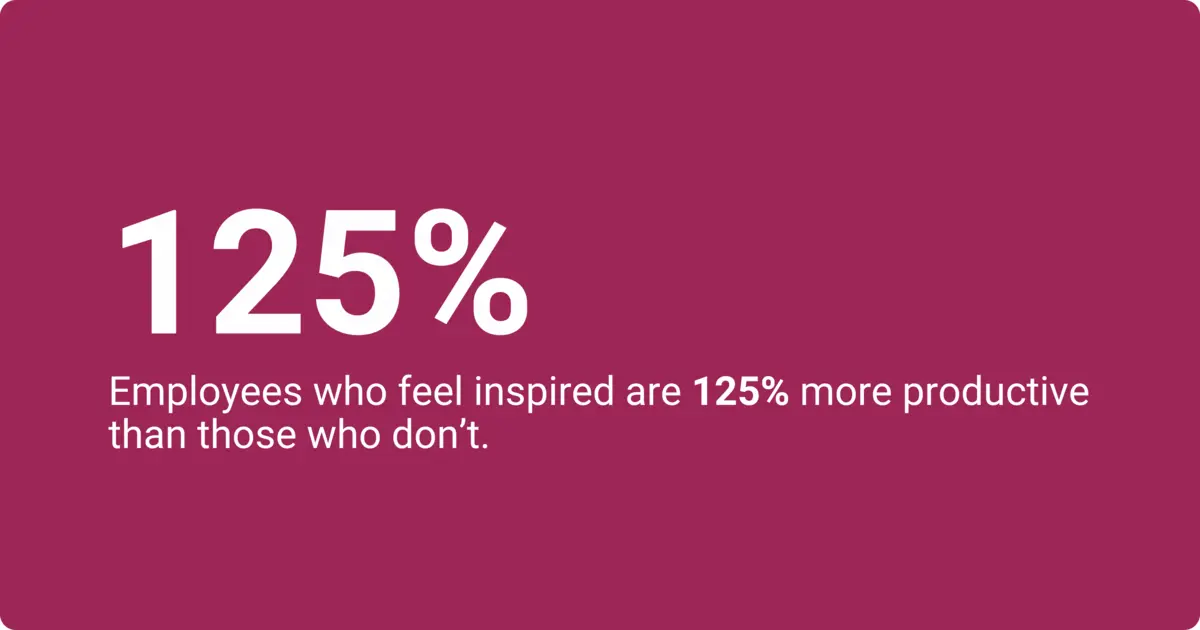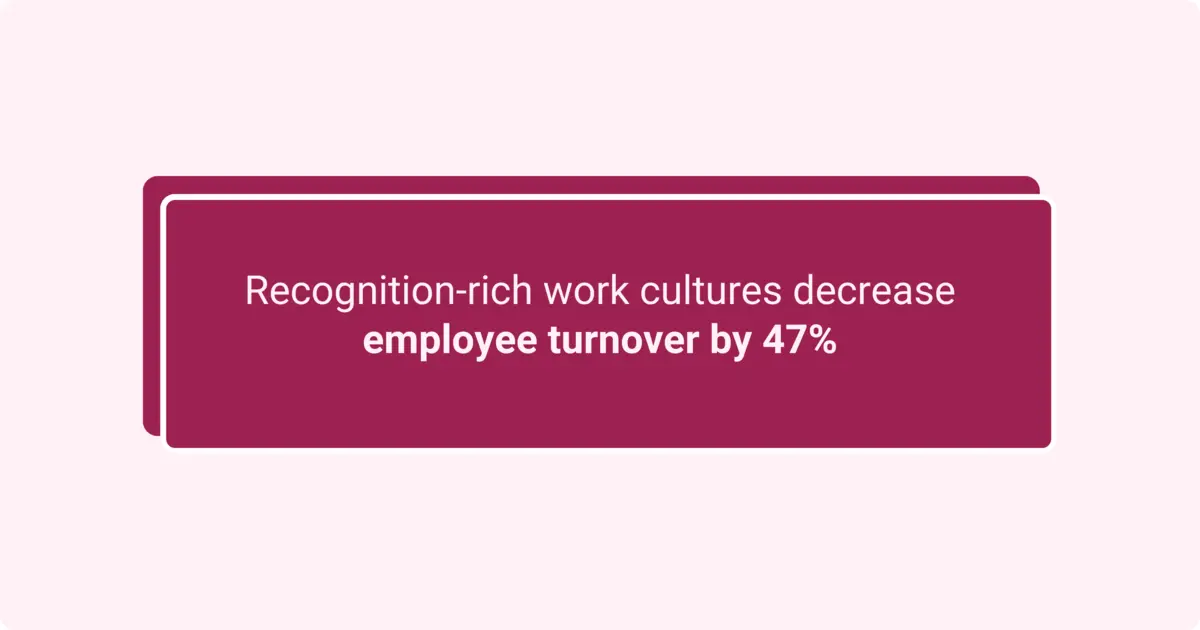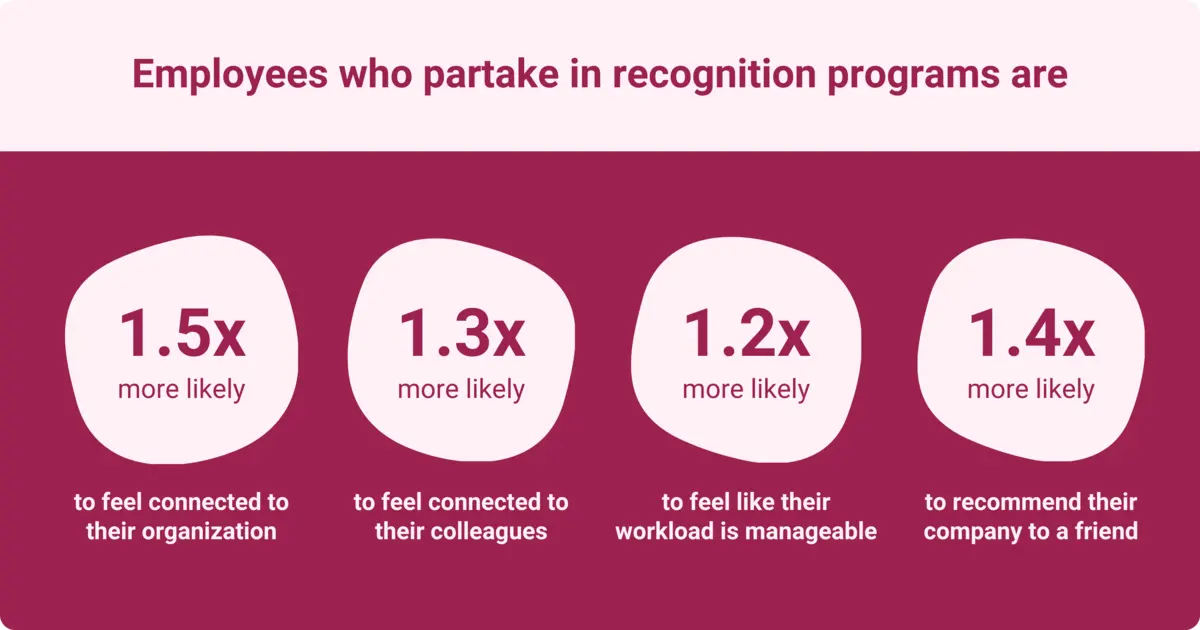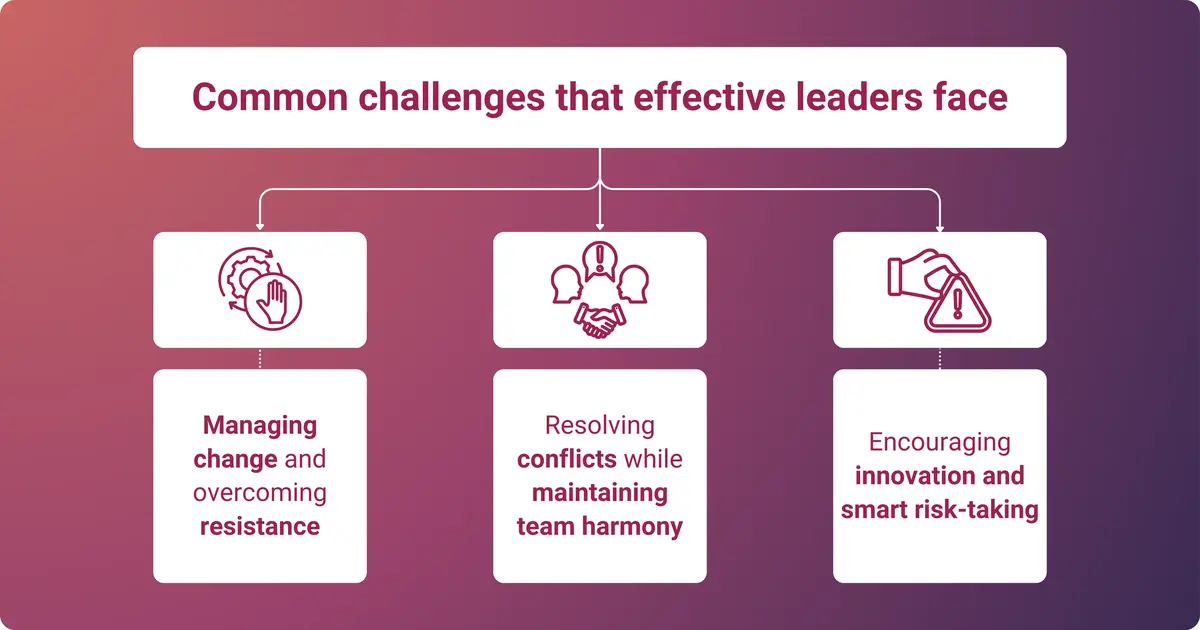What is Effective Leadership? Learn the Essential Qualities, Workplace Impact, and Potential Challenges
Table of contents
- What is effective leadership?
- What are the essential qualities/characteristics of effective leaders?
- Why are effective leadership skills important in the workplace?
- What are the differences between effective leadership and management?
- What challenges do effective leaders face?
- Effective leadership examples
- Conclusion

The life force behind team morale, and something that is an intrinsic part of shaping business success, is effective leadership.
So, why do businesses struggle to achieve leadership success? A Gallup study on U.S. employees' perceptions of their leaders and managersOpens in a new tab found that only 20% of employees strongly agree that they trust their organization's leadership.
This shows that old-school, top-down leadership isn’t cutting it anymore. Poor leadership also fails in today’s environment. Today’s employees want collaborative environments that provide recognition and trust, not just orders from above.
How do you make that perfect balance between decisiveness and inclusiveness? In this guide, you’ll dive into what makes leadership effective, the challenges leaders face when adapting to today’s expectations, and how it shapes the workplace for good or for bad.
What is effective leadership?
The most important leadership competencies involve making calls and managing teams. However, they also encompass the creation of a supportive environment that empowers individuals, propelling motivation. It is up to you to create a space that cultivates trust and brings the best out of every stakeholder. This is a key leadership trait among great leaders.
The best leaders are the ones who blend strategic thinking with emotional intelligence and apply it so they make certain employees feel truly valued and heard.
Leaders need to combine their authority with well-intentioned influence. Research by Gallup and Workhuman on the impact of recognition in the workplace found that employees are five times as likely to be engaged when they get valuable feedback about their performance.
The best leaders make the effort to nurture their team on top of directing tasks. They are a direct source of communication that helps cultivate a culture where people thrive.
At its core, great leadership is all about traits like integrity, resilience, motivation, and communication. When leaders live by these values, they don’t just build a successful team — they create a workplace where people want to blossom.
What are the essential qualities/characteristics of effective leaders?
Leadership styles may differ, but learning how to be a great manager and leader, regardless of the leadership approach you take, doesn’t need to be hard. All great leaders share a few key traits that set them apart. These qualities help them tackle challenges that build trust, leading their teams to success. Here are the essentials that define truly great leaders:
Leading with integrity and transparency
Integrity is the bedrock of great leadership. Leaders who prioritize honesty and transparency while having an ethical attitude toward decision-making create a sense of trust and clarity within their teams. Employees need to know their leaders will act fairly and openly even when things get tough.
Ethical leadership demonstrates integrity, and these leaders create a space where employees peek above the parapet to share ideas and act boldly, contributing meaningfully to the organization’s success.
Satya Nadella, CEO of Microsoft, transformed the company’s culture by championing transparency and a growth mindset. By openly discussing setbacks and fostering a culture of learning from criticism while finding inspiration in everyone's successes, he helped Microsoft evolve into a learning-first business.
Resilience and adaptability in leadership
There is a multitude of business challenges in economic downturns, from industry disruptions to internal upheaval. Resilient leaders remain steady and composed, ready with forward-thinking ideas. Great leaders handle change well and even thrive in it. To them, adaptability is integral, and being agile can mean the difference between success and stagnation.
Practical tips for building resilience as a leader:
- Stay solution-oriented: Focus on what can be done rather than dwelling on setbacks.
- Encourage a growth mindset: Forge a team culture that views challenges as opportunities to learn.
- Lean on support systems: Become a leader who knows when to seek advice and collaborate with others.
- Recognize your team’s efforts: Celebrate achievements through platforms like Workhuman’s® Social Recognition™ that help reinforce resilience and boost morale.
Workhuman is the #1 provider of employee recognition software. When you opt for recognition done right from Workhuman, you don't have to settle for second-rate recognition.
Motivating and inspiring teammates
Leaders who inspire and motivate directly impact workplace engagement and productivity. A Bain & Company paper found that employees who feel inspired are 125% more productive than those who don’t. But motivation isn’t just offering incentives. It’s creating a sense of purpose.

How to bump up motivation on your team:
- Align work with purpose: Help employees see how their contributions impact the company’s mission.
- Recognize achievements regularly: Give public recognition that reinforces positive behavior and increases engagement.
- Lead by example: Demonstrate enthusiasm and commitment because your energy is contagious.
- Encourage collaboration: Enrich an environment with inclusivity where everyone feels valued.
Effective communication
Communication is at the heart of leadership. Effective leaders set expectations, provide feedback, and deliver the company’s vision. They communicate clearly, persuasively, and empathetically.
Miscommunication can breed confusion, which can erode trust and lead to disengagement. Conversely, effective communication sparks alignment and gives teamwork momentum.
Core elements of effective leadership communication:
- Clarity: Make sure messages are straightforward and actionable.
- Empathy: Listen actively and acknowledge employees' perspectives.
- Consistency: Reinforce key messages across multiple channels.
- Two-way dialogue: Encourage feedback and open discussions.
Leaders who prioritize effective communication build workplaces where messages land and employees feel truly heard and valued. A tool like Workhuman's Conversations® makes it easy to keep the feedback flowing and check-ins meaningful, so communication is continuous and impactful.
Emotional intelligence
Emotional intelligence (EQ) is a leader’s ability to understand and manage their emotions while recognizing and influencing the emotions of others. High EQ leaders are strong relationship builders who create positive work environments. Building emotional intelligence will enhance your ability to make more thoughtful decisions. This fosters a collaborative culture rooted in understanding and support.
The four main components of emotional intelligence:
- Self-awareness: Understanding your strengths, weaknesses, and triggers
- Self-regulation: Managing emotions effectively and staying composed under pressure
- Empathy: Actively listening and considering others’ perspectives
- Social skills: Building strong relationships and resolving conflicts constructively
Decision-making skills
The best leaders are defined by their ability to make intelligent, strategic decisions. Whether in day-to-day operations or high-stakes situations, strong decision-making skills make for a steady hand and promote progress.
How to enhance your decision-making as a leader:
- Gather diverse perspectives: Welcome input from team members to make well-rounded choices.
- Rely on data: Use analytics, like insights from Workhuman iQ, to guide evidence-based decisions.
- Assess risks and benefits: Weigh potential outcomes before committing to a course of action.
- Trust your intuition: Lean on your experience and emotional intelligence to make decision-making effective.
Why are effective leadership skills important in the workplace?
Strong leadership skills encourage a dynamic workplace that brings innovation, accountability, and an acute sense of purpose to the forefront. Leaders set the tone for company culture and influence engagement and the experience employees have in their day-to-day work. When leadership operates at the highest level, employees are more likely to feel empowered and aligned with organizational goals.
Strong leadership:
- Enhances team performance: A great leader brings out the best in employees, encouraging them to grow and excel, ensuring team success.
- Strengthens organizational culture: Leadership sets the standard for workplace values, communication, and behavior.
- Bolsters business success: Engaged employees lead to higher productivity, innovation, and retention.
Workhuman and Gallup research shows that recognition-rich cultures decrease employee turnover by 47%. This reinforces the idea that leadership isn’t just about directing. It’s about empowering people to succeed.

Strengthening team dynamics through leadership
Teamwork is the engine that drives success, and leaders are the fuel. They bring people together, promote collaboration, and guide employees through conflict. When leaders focus on team dynamics, they build a culture where everyone has each other’s back and works toward shared goals.
Ways leaders can strengthen team dynamics:
- Encourage open communication: A culture of transparency allows concerns and ideas to flow freely.
- Recognize team achievements: A shared sense of celebration through social and individual recognition reinforces collaboration and motivation.
- Mediate conflicts constructively: A head-on approach to disagreements with an emphasis on fairness and resolution gets you quickly past issues.
- Foster a sense of belonging: A space where all voices are heard and valued within the team creates unity.
Creating a positive and inclusive work environment
Creating a culture where everyone feels valued and safe to be themselves will foster mutual respect. Employees thrive when they feel included, and it's good for business.
Here's a few ways leaders can promote inclusivity:
- Encourage diverse perspectives: Actively seek input from employees with different backgrounds and experiences to have a melting pot of fresh ideas.
- Lead with empathy: Acknowledge challenges and support employees in meaningful ways.
- Recognize contributions fairly: Use tools that make appreciation equitable across all levels of the organization.
- Commit to continuous learning: Use vetted resources to implement best practices.
Increasing productivity with recognition and support
Setting goals is one thing, but aligning team efforts with business objectives in a way that keeps employees engaged and motivated is the key to success. One of the most powerful ways to achieve this is through recognition and support.
When leaders actively acknowledge employee contributions, they strengthen positive attitudes and behaviors that reinforce success and create a culture where people feel like they make an impact.
Research by Workhuman found that organizations with a strong culture of recognition see higher productivity and improved overall performance. When employees know their efforts contribute to something bigger, they are more likely to stay engaged and committed to their work.
How leaders can drive productivity through recognition:
- Make recognition frequent and specific: Call out achievements regularly to reinforce positive behaviors.
- Tie recognition to company values: Align praise with strategic goals to keep employees focused on what matters.
- Encourage peer-to-peer recognition: Let employees acknowledge each other’s contributions, building connections and a culture of support.
- Offer meaningful support: Give employees the tools, resources, and guidance they need to perform at their best.

Boosting morale through feedback
Morale is the heartbeat of progress. When employees receive regular, constructive feedback tied in with a culture of curiosity and constant learning, they feel supported and motivated to improve. Leaders who provide feedback in a way that is actionable alongside encouragement help employees grow.
According to Workhuman's research, a culture of continuous feedback leads to stronger connections between employees and managers, making it easier to address challenges and celebrate wins.
Ways to boost morale through effective feedback:
- Make feedback ongoing: Move beyond annual reviews to provide more timely coaching.
- Balance praise with constructive guidance: Acknowledge strengths while offering actionable areas for growth and how to get there.
- Encourage two-way dialogue: Bring in employees to have their say so you can receive feedback for improvement.
- Recognize progress, not just results: Celebrate effort and improvement, not just final achievements.
What are the differences between effective leadership and management?
Leadership and management are often grouped together, but they serve different purposes in an organization. While both are crucial, leadership is all about vision and influence, whereas management is about getting things done and staying organized.
The differences between leaders and managers:
- Leaders inspire and motivate others to reach a long-term vision. They are the source of change and innovation.
- Managers implement processes and oversee daily operations, keeping task completion on schedule.
- Leaders focus on people by empowering teams and helping build relationships in a nurturing, positive culture.
- Managers focus on systems, optimizing workflows, and maintaining the structure.
The best leaders know when to take charge and when to steer the ship. In fast-paced environments, leadership sets the course and fires up the team, while solid management keeps things on track and running smoothly.
Leadership vs. management – when to direct and when to inspire
Leaders who understand when to inspire and when to direct will produce the best results. While leadership is about setting a vision, management is about providing structure to make that vision a reality.
When to use directive management:
- During crisis situations when quick, decisive action is needed
- When employees need clear guidance and expectations to complete tasks
- In highly regulated industries where compliance and precision are crucial
When to use inspirational and transformational leadership:
- When introducing change or innovation
- When building a high-performance culture based on trust and engagement
- When motivating employees to exceed expectations and think creatively
Let's take a high-pressure project with tight deadlines as an example. Managers may need to take a directive approach to keep everything on track. On the other hand, when guiding a team through a company-wide transformation, leadership qualities such as vision and empathy with great communication become more valuable.
Balancing short-term objectives with long-term vision
Successful leaders don’t just live in the moment. They’re always planning ahead, making sure short-term goals align with long-term success. Balancing today’s priorities with tomorrow’s vision? That’s the mark of a true leader.
How leaders balance short-term goals with long-term vision:
- Set clear priorities: Make sure day-to-day tasks contribute to overarching business objectives.
- Adapt to changing conditions: Stay flexible while keeping long-term goals in focus.
- Empower employees to think ahead: Encourage innovation and a forward-thinking mindset.
- Use recognition to reinforce long-term goals: Use platforms like Meaningful Milestones to help align daily efforts with company values and long-term vision.
Experience the power of Service Milestones in your organization.
What challenges do effective leaders face?
Even the most experienced leaders hit roadblocks that test their ability to inspire and guide. In today’s business world, leaders face everything from resistance to change to the push for innovation. The best rise to the challenge, crafting solutions that fuel both personal and organizational growth. Here are the top challenges leaders face and potential solutions:

Managing change and overcoming resistance
Change is inevitable, but resistance is part of the deal. As a leader, it’s on you to guide your team through the transitions, easing concerns and minimizing the bumps along the way. Whether it's embracing new tech, reshuffling teams, or facing reactions from shifting priorities, great leadership helps employees adapt rather than fight change.
How to manage change effectively:
- Communicate the reasons for change clearly: Help employees understand the why behind the transition.
- Provide support during the transition: Offer training and resources alongside consistent feedback to ease the process.
- Involve employees in the process: Ask for input and make employees feel like they’re part of the change.
- Celebrate milestones: Acknowledge progress to keep morale high and motivation strong.
Resolving conflicts while maintaining team harmony
Conflict is a natural part of any team dynamic, but human-centric leadership knows how to turn conflicts into opportunities for growth and improvement. Resolving conflicts requires mediation and a thorough understanding of team dynamics. When done correctly, conflict resolution leads to stronger relationships and better collaboration.
Strategies for resolving conflict effectively:
- Act quickly and impartially: Address conflicts before they escalate without taking sides.
- Create open dialogue: Encourage team members to share their concerns and perspectives.
- Find common ground: Help parties identify shared goals and work toward a collaborative solution.
- Use conflict as a learning opportunity: Turn disagreements into chances for constructive feedback.
Encouraging innovation and smart risk-taking
Innovation is the engine of growth, but it often comes with uncertainty. Effective leaders cultivate a culture where employees feel comfortable experimenting and taking calculated risks. It’s not about promoting chaos but rather valuing creativity and new ideas that push the boundaries.
Leadership strategies for encouraging innovation:
- Lead by example: Show that you are open to new ideas and are willing to take risks.
- Provide a safe space for experimentation: Support employees in trying new approaches without the fear of failure.
- Recognize and reward innovation: Celebrate creative solutions and smart risks, reinforcing the importance of innovation.
- Foster cross-functional collaboration: Bring together employees with diverse skills to tackle problems from different angles.
A culture of innovation flourishes when employees feel supported and empowered to think outside the box. Companies that take calculated risks, whether breaking into new markets or pioneering cutting-edge tech, rise to become industry leaders.
Effective leadership examples
Inspiration can be found in the stories of successful leaders who have overcome adversity to reach greatness. Whether in business, politics, or innovation, these leaders have demonstrated qualities and a strong vision that brought them success.
Case studies of effective leadership:
- Steve Jobs, co-founder of Apple: Jobs was known for his visionary leadership, driving Apple’s transformation into an industry leader in innovation. His ability to challenge the status quo and inspire his team to create groundbreaking products was central to Apple’s success.
- Nelson Mandela, former president of South Africa: Mandela’s leadership was defined by his unwavering commitment to justice, equality, and reconciliation. By focusing on unity rather than division, he helped South Africa transition peacefully from apartheid to democracy.
- Indra Nooyi, former CEO of PepsiCo: Nooyi’s leadership was rooted in her commitment to sustainability and innovation. Under her guidance, PepsiCo embraced healthier products and environmental responsibility while maintaining strong financial growth.
These leaders exemplify the power of combining the right leadership qualities to drive long-term success. By studying their strategic leadership styles, you can gain valuable insights into how to inspire and motivate your teams.
Conclusion
As we've seen, effective leadership development is a blend of behaviors and attitudes that empower teams to reach their full potential. By mixing human creativity with data-driven insights, leaders can make decisions that truly move the needle and create a culture of constant growth.
The future of leadership is all about finding the sweet spot between tech and human connection, making sure both work in sync to drive the organization forward.
By embracing this, you can improve the collaborative mindset between the people in your organization. You can make it easier to tackle challenges and grab opportunities in a world that’s always shifting.